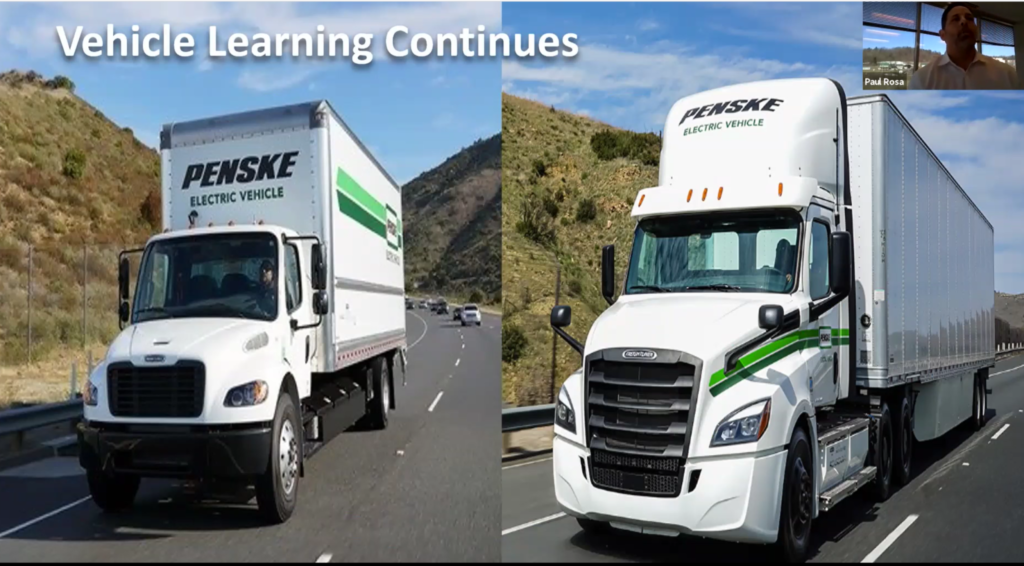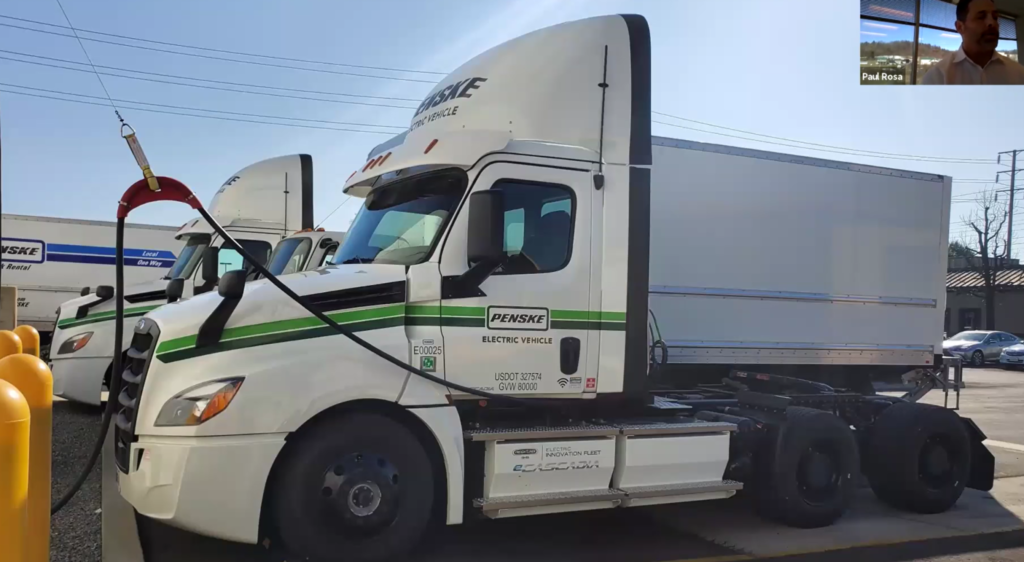Penske SVP sees long path for electric trucks
Interest in electric trucks continues to grow, but Penske’s Paul Rosa believes the journey to zero emissions will be a long one.
“Adoption will take longer than expected,” the senior vice-president – procurement and fleet planning said during an online keynote address for the Work Truck Show.

His fleet has seen medium-duty trucks move from six-speed manuals to automatic transmissions, and heavy trucks introduce collision mitigation systems. But those updates pale in comparison to the change from internal combustion engines to zero-emission vehicles, he said.
Looking at equipment volumes alone, Rosa said there are about 4.5 million Class 4-8 vehicles on U.S. roads when including trucks and buses. If every OEM immediately began building nothing but zero-emission trucks today, it would still take nine years by his calculations to switch everything to electric vehicles.
While electric trucks are beginning to emerge, he recognizes the technology is still relatively immature. It could be a decade before the total cost of ownership improves and related charging infrastructure begins to expand.
The promise of long-life and low-cost batteries could be further away than that. Batteries currently cost about $200 per kilowatt-hour, Rosa says. That’s about one-fifth what they cost a decade ago, but double the costs that will bring them in line with diesel.
“This is going to take some time,” he said. “You need to be ready, but you need to be patient.”

More questions than answers
During his presentation, the Penske executive identified more questions than answers when it comes to integrating the equipment into a fleet.
Finding the proper fit for a fleet can be one of the biggest challenges, he says. Operations will need to know if truck chassis can be upfitted or converted, if potential payloads will support the entire operation, and how charging schedules might align with Hours of Service.
“The batteries are what they are. They’re heavy,” Rosa says. There are still questions about the total cost of ownership, the required charging networks and processes, and the spec’s.
“Is the maintenance cost undersood yet? No.”
Penske is committed to finding answers, though. It is evaluating electric trucks in a series of real-world tests. Each has faced “operational issues”, but the point of a test is to understand the issues that exist.
“You must have a solid vehicle strategy and quickly implement your charging solutions or you’re falling behind,” Rosa says. “It does you no good to have a costly electric vehicle parked when you can’t charge it.”
One of the challenges is that the questions reach well beyond trucks alone, considering charging infrastructure and power grids alike. Fleet facilities can need to be modified, and any charging models will need to support growth.
Beyond that there are questions about the power source itself, such as how it will be generated. Solar and wind farms currently account for about 15% of power generation. The green energy may not always be close at hand.
Charging 20 battery electric trucks for a full battery cycle will draw as much electricity as an average home uses in a year. One truck will use the energy consumed by 12 homes a year.
Goals to replace carbon fuels are based on projected dates like 2040. “That’s far into the future,” he says. “Decisions are being made today.”
At a local level, substations and transformers might need to be upgraded to support electric trucks, and growing demand could delay utility upgrades by months or a year. Finding a contractor to upgrade panels and finding the related permits could be another challenge.
A battery-based storage system based at a Penske location in Ontario, California, is looking to manage charging times. But it also needs to be recharged after charging two Class 8 vehicles. The fleet is looking at using the truck batteries to store energy for other vehicles, too.
Penske currently has six DC fast charging locations in California, supporting its participation in Daimler Trucks North America’s innovation fleet.
“We had more ideal locations that had much better footprint for space,” he says, “but they required extensive upgrades to the charging and the building.”
“All this is going to require some serious technology investments,” Rosa says of electric vehicles. “I wish it would be faster because customers are very excited about this.”
Have your say
This is a moderated forum. Comments will no longer be published unless they are accompanied by a first and last name and a verifiable email address. (Today's Trucking will not publish or share the email address.) Profane language and content deemed to be libelous, racist, or threatening in nature will not be published under any circumstances.
-
Hydrogen cost way too much to be used as a viable fuel it’s simply a higher upfront cost to extract an produce hydrogen much easier to produce electricity from wind solar and wave or ocean,. As strange as it may seam electricity is the most widely used energy on earth. I the word of Elon Musk Hydrogen is just just plain stupid, remember Elon is an engineer not just a millionaire but an inventor /scientist
This dude is simply not fully informed about the state of the industry they (traditional OEMs) will be left behind by Tesla. It’s not rocket science it’s just electricity. Sounds like Penske is willing to keep Fuel truck around for another 25years his is simply not gonna cut it, and besides we owe it to Greta Tunburg we just can’t let the kid down
As usual, great article and insight from you, John. Have you seen any studies on the use of Hydrogen, from any and all sources, bridging the gap between now and when the infrastructure and economic viability of Electric for trucking is ready?
There may be, by all accounts, a huge problem when we have such electricity demand and the generation and transmission is already strained. It would be great to get your take on other options until that gap is closed.
Or, am I too pessimistic on the realization of this love of batteries and the reality of supplying it to the mass market?
Thanks again John for your thought provoking article.